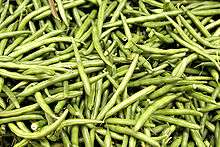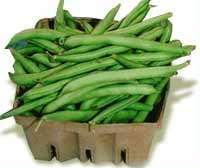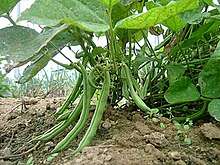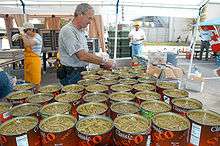Green bean



Green beans are the unripe, young fruit and protective pods of various cultivars of the common bean (Phaseolus vulgaris).[1][2] Immature or young pods of the runner bean (Phaseolus coccineus), yardlong bean (Vigna unguiculata subsp. sesquipedalis), and hyacinth bean (Lablab purpureus) are used in a similar way.[3] Green beans are known by many common names, including French beans,[4] string beans (for old varieties; modern varieties are stringless),[4] snap beans,[4] snaps,[5][6] and even the French: haricots vert.
They are distinguished from the many other varieties of beans in that green beans are harvested and consumed with their enclosing pods, before the bean seeds inside have fully matured. An analogous practice is the harvest and consumption of unripened pea pods, as is done with snow peas or sugar snap peas.
Historically, green bean pods contained a string, a hard fibrous strand running the length of one side of the pod. This string was either removed before cooking, or made swallowable by cutting the pod into short segments. Modern, commercially grown green bean varieties are stringless and lack strings, though heirloom varieties may retain this trait.
Culinary use and nutrition
| Nutritional value per 100 g (3.5 oz) | |
|---|---|
| Energy | 131 kJ (31 kcal) |
|
6.97 g | |
| Dietary fiber | 2.7 g |
|
0.22 g | |
|
1.83 g | |
| Vitamins | Quantity %DV† |
| Vitamin A equiv. |
4% 35 μg |
| Thiamine (B1) |
7% 0.082 mg |
| Riboflavin (B2) |
9% 0.104 mg |
| Niacin (B3) |
5% 0.734 mg |
| Pantothenic acid (B5) |
5% 0.225 mg |
| Vitamin B6 |
11% 0.141 mg |
| Folate (B9) |
8% 33 μg |
| Vitamin C |
15% 12.2 mg |
| Vitamin K |
14% 14.4 μg |
| Minerals | Quantity %DV† |
| Calcium |
4% 37 mg |
| Iron |
8% 1.03 mg |
| Magnesium |
7% 25 mg |
| Manganese |
10% 0.216 mg |
| Phosphorus |
5% 38 mg |
| Potassium |
4% 211 mg |
| Zinc |
3% 0.24 mg |
| Other constituents | Quantity |
| Fluoride | 19 µg |
|
| |
| |
|
†Percentages are roughly approximated using US recommendations for adults. Source: USDA Nutrient Database | |

.jpg)

Green beans are eaten around the world, and are sold fresh, canned, and frozen. They can be eaten raw or steamed, boiled, stir-fried, or baked in casseroles.
A dish with green beans popular throughout the US, particularly at Thanksgiving, is green bean casserole, a dish of green beans, cream of mushroom soup, and French-fried onions.[7] Some US restaurants serve green beans that are battered and fried, just as some Japanese restaurants serve green bean tempura. Green beans are also sold dried, and/or fried with vegetables such as carrots, corn, and peas, as vegetable chips.
Nutritionally, green beans are a healthy vegetable and the flavonol miquelianin (Quercetin 3-O-glucuronide) can be found in green beans.[8]
Characteristics
The first "stringless" bean was bred in 1894 by Calvin Keeney, called the "father of the stringless bean", while working in Le Roy, New York.[9] Most modern green bean varieties do not have strings.[3]
Plant
Green beans are classified by growth habit into two major groups, "bush" (or "dwarf") beans and "pole" (or "climbing") beans.[10][11][12]
- Bush beans are short plants, growing to not more than 2 feet (61 cm) in height, often without requiring supports. They generally reach maturity and produce all of their fruit in a relatively short period of time, then cease to produce. Owing to this concentrated production and ease of mechanized harvesting, bush-type beans are those most often grown on commercial farms. Bush green beans are usually cultivars of the common bean (Phaseolus vulgaris).
- Pole beans have a climbing habit and produce a twisting vine, which must be supported by "poles", trellises, or other means. Pole beans may be common beans (Phaseolus vulgaris), runner beans (Phaseolus coccineus) or yardlong beans (Vigna unguiculata subsp. sesquipedalis).[13][14]
Half-runner beans have both bush and pole characteristics, and are sometimes classified separately from bush and pole varieties.[15][16][17][18] Their runners can be about 3–10 feet long.[19]
Varieties
Over 130 varieties of green bean are known.[20] Varieties specialized for use as green beans, selected for the succulence and flavor of their pods, are the ones usually grown in the home vegetable garden, and many varieties exist. Pod color can be green, purple, red, or streaked.[21] Shapes range from thin "fillet" types to wide "romano" types and more common types in between. Yellow-podded green beans are also known as wax beans.[3]
All of the following varieties have green pods and are Phaseolus vulgaris, unless otherwise specified:
Bush (dwarf) types
Pole (climbing) types
Production
According to UN Food and Agriculture Organization (FAOSTAT), the top producers of green beans (in metric tonnes) in 2012.[23]
| Rank | Country | Production (t) |
|---|---|---|
| 1 | 16,200,000 | |
| 2 | 871,170 | |
| 3 | 620,000 | |
| 4 | 614,960 | |
| 5 | 305,000 | |
| 6 | 251,279 | |
| 7 | 165,400 | |
| 8 | 134,124 | |
| 9 | 133,744 | |
| 10 | 94,356 | |
| World | 20,742,857 |
References
- ↑ "Green Beans". The World's Healthiest Foods. Retrieved March 2, 2017.
- 1 2 3 4 5 6 7 "Beans – Vegetable Directory – Watch Your Garden Grow – University of Illinois Extension".
- 1 2 3 "Growing beans in Minnesota home gardens". University of Minnesota Agricultural Extension. Retrieved September 20, 2016.
- 1 2 3 Green, Aliza. Field Guide to Produce. p. 126.
- ↑ Singh BK and Singh B. 2015. Breeding perspectives of snap bean (Phaseolus vulgaris L.). Vegetable Science 42(1): 1-17.
- ↑ Hatch, Peter J. "A Rich Spot of Earth": Thomas Jefferson's Revolutionary Garden at Monticello. pp. 159–161.
- ↑ Cook's Illustrated (2004). The New Best Recipe. America's Test Kitchen.
- ↑ Antioxidant properties of flavonol glycosides from green beans. Plumb G.W., Price K.R. and Williamson G., Redox Report, Volume 4, Number 3, June 1999, pages 123-127, doi:10.1179/135100099101534800
- ↑ Taylor's guide to heirloom vegetables. Boston: Houghton Mifflin. 1996. ISBN 0-395-70818-4.
- ↑ McGee, Rose Marie Nichols; Stuckey, Maggie (2002). The Bountiful Container. Workman Publishing.
- ↑ Garrelts, C.; Garrelts, Megan; Lee, Bonjwing (2011). Bluestem: The Cookbook. Andrews McMeel Publishing. p. 71. ISBN 978-1-4494-0061-3.
- 1 2 3 4 How to Grow French Beans – Royal Horticultural Society, RHS Gardening
- ↑ Capomolla, F. (2017). Growing Food the Italian Way. Pan Macmillan Australia. p. 143. ISBN 978-1-76055-490-3. Retrieved February 26, 2018.
- ↑ Watson, B. (1996). Taylor's Guide to Heirloom Vegetables. TAYLOR'S WEEKEND GARDENING GUIDES. Houghton Mifflin. p. 238. ISBN 978-0-395-70818-7. Retrieved February 26, 2018.
- ↑ "Planting Directions for White Half-Runner Beans". sfgate.com. Retrieved May 24, 2018.
- ↑ Torpey, Jodi (January 9, 2016). "Blue Ribbon Vegetable Gardening: The Secrets to Growing the Biggest and Best Prizewinning Produce". Storey Publishing. Retrieved May 24, 2018 – via Google Books.
- ↑ Wonning, Paul R. "Gardeners' Guide to Growing Green Beans in the Vegetable Garden: The Green Bean Book – Growing Bush, Pole Beans For Beginning Gardeners". Mossy Feet Books. Retrieved May 24, 2018 – via Google Books.
- ↑ Gutierrez, Sandra A. (October 15, 2015). "Beans and Field Peas: a Savor the South® cookbook". UNC Press Books. Retrieved May 24, 2018 – via Google Books.
- ↑ Séguret, Susi Gott (January 24, 2017). "Appalachian Appetite: Recipes from the Heart of America". Hatherleigh Press. Retrieved May 24, 2018 – via Google Books.
- ↑ Facciola, Stephen (1998). Cornucopia II : a source book of edible plants. Kampong Publications. ISBN 0-9628087-2-5.
- ↑ Singh B K, Pathak K A, Ramakrishna Y, Verma V K and Deka B C. 2011. Purple-podded French bean with high antioxidant content. ICAR News: A Science and Technology Newsletter 17 (3): 9.
- ↑ Runner beans are beautiful and edible – Oregon State University Agricultural Extension
- ↑ "Production of Green Bean by countries". UN Food and Agriculture Organization. 2011. Archived from the original on July 13, 2011. Retrieved February 2, 2015.
External links
| Wikibooks Cookbook has a recipe/module on |
| Wikimedia Commons has media related to Green beans. |